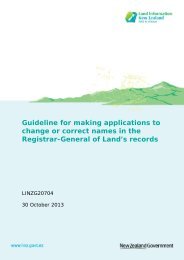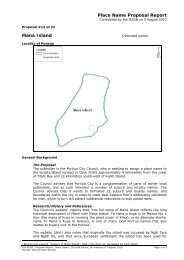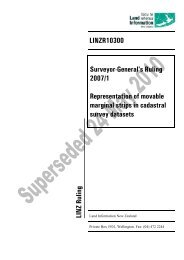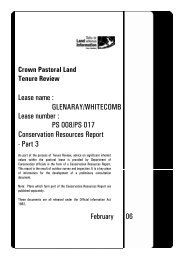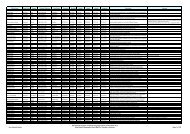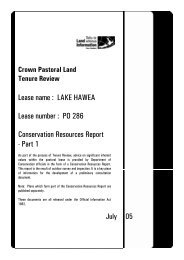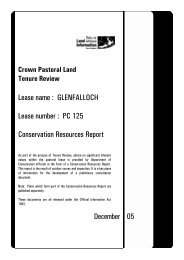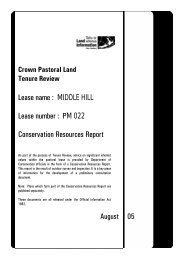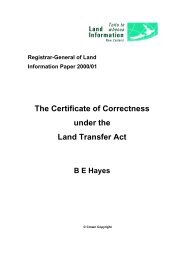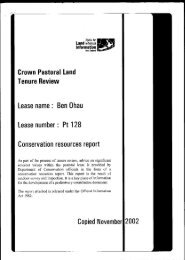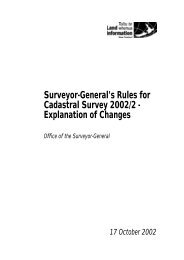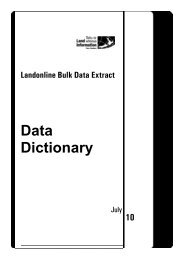Part 1 - Land Information New Zealand
Part 1 - Land Information New Zealand
Part 1 - Land Information New Zealand
You also want an ePaper? Increase the reach of your titles
YUMPU automatically turns print PDFs into web optimized ePapers that Google loves.
RELEASED UNDER THE OFFICIAL INFORMATION ACT<br />
Rare Ecosystems<br />
Terrestrial ecosystems that were rare before human colonisation of <strong>New</strong> <strong>Zealand</strong> often have<br />
highly specialised and diverse flora and fauna characterised by endemic and nationally rare<br />
species. Rare ecosystems are defined as those having a total extent less than 0.5% (i.e. < 134 000<br />
ha) of <strong>New</strong> <strong>Zealand</strong>’s total area (268 680 km2). A framework has been developed (Williams et al.<br />
2007) based on descriptors of physical environments that distinguish rare ecosystems from each<br />
other and from more common ecosystems. Using this framework 72 rare ecosystems have been<br />
defined using pertinent environmental descriptors selected from soil age, parent material, soil<br />
chemistry and particle size, landform, drainage regime, disturbance, and climate<br />
Three rare ecosystems were identified on the PL, all in the wetland category (cushion bogs,<br />
seepages and flushes, and ephemeral wetland).<br />
2.5.2 Problem Plants<br />
At least 35 exotic species of plants are present on the PL but relatively few are of conservation<br />
concern. Many are plants of agricultural importance or are common pastoral weeds. Most are<br />
present only at lower elevations. At least two hawkweed species are present but are seldom<br />
common except in localised dry sites where all taller vegetation has been removed. Of most<br />
serious concern are the Douglas fir infestations that occupy the Roaring Meg gorge and lower<br />
Meg faces. Their further spread presents a risk to lower stature vegetation throughout the PL.<br />
Other wilding Pinus sp. will also require ongoing vigilance to prevent their establishment in<br />
priority areas. At the time of the 2012 inspection work was underway to remove the wilding tree<br />
infestation in the vicinity of the Roaring Meg.<br />
Broom, elder, bittersweet, and Old Man’s Beard also present a threat to the ecological integrity of<br />
montane shrubland communities. Although currently at low density, control of these species is<br />
desirable in shrubland areas identified as containing SIVs.<br />
2.6 Fauna<br />
2.6.1 Invertebrate Fauna<br />
No invertebrate survey of the PL has been undertaken; however as with many of the Central<br />
Otago mountains, the subalpine and alpine zones of the Pisa Range support a rich fauna by <strong>New</strong><br />
<strong>Zealand</strong> standards, usually associated with less modified vegetation. While the Pisa Range is part<br />
of the alpine core of Central Otago, with a characteristic Central Otago fauna, it has extra diversity<br />
because of distributional overlaps with species characteristic of the wetter mountains of northwest<br />
Otago (Ward et al. 1994). It forms the eastern limit for a number of species including the<br />
yellow tortricid moth Ascerodes prochlora.<br />
The Pisa Range has its own endemic black butterfly, Percnodaimon sp. which is locally<br />
distributed across the tops (B. Patrick pers. comm.). Although there are no known endemic moths,<br />
there are many moth species that have distributions shared between the Pisa Range and one or two<br />
of the adjacent ranges (B. Patrick pers. comm.)<br />
The Pisa Range is the Type locality for two species of stoneflies: Zelandobius inversus and Z.<br />
mariae, and was the only known site for these two species at the time of description (McLellan<br />
1993).<br />
14



